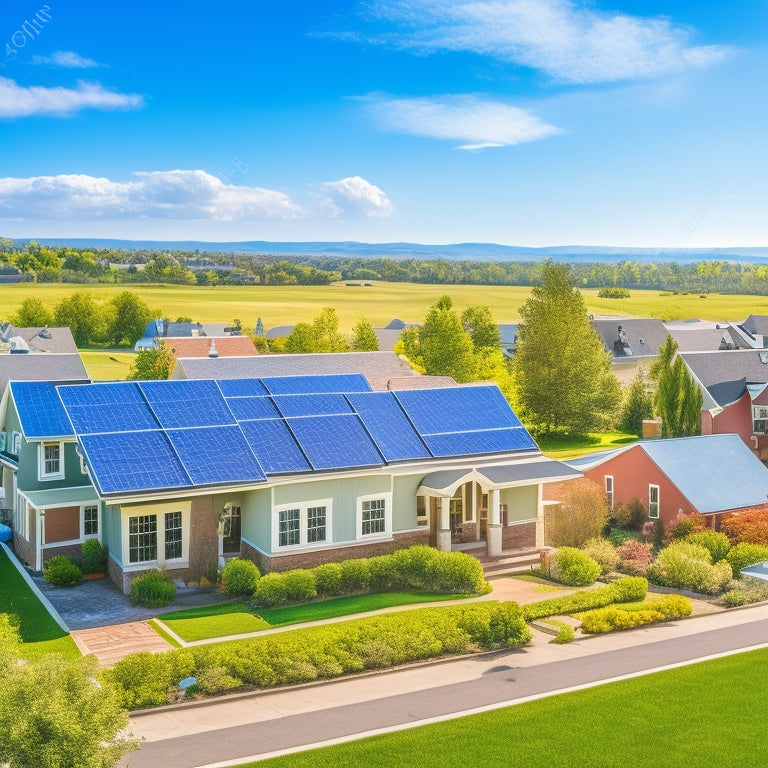
What's the Average Cost of Solar Panels Installed?
Share
You're considering installing solar panels and want to know the average cost. Nationally, solar panels cost between $2.50 and $3.50 per watt, with a typical residential system costing $15,000 to $20,000. However, your final bill can vary considerably depending on factors like system size, equipment quality, and local incentives. Additionally, installation costs, labor fees, and permits add to the overall expense. But don't worry, federal and state incentives can help offset the upfront costs. As you explore your options, you'll discover more about how these variables interact to determine your total investment.
Key Takeaways
• The national average cost of solar panels installed ranges from $2.50 to $3.50 per watt, translating to $15,000 to $20,000 for a typical residential system.
• The federal solar investment tax credit allows for a 26% tax credit, reducing the upfront cost of solar panel installation.
• The cost of solar panels varies by state due to differing incentives, labor costs, and regional pricing trends.
• A well-designed solar panel system ensures energy efficiency and reduces waste, with typical residential systems ranging from 3,000 to 10,000 watts.
• Equipment quality, installation complexity, and labor costs significantly impact the final cost of solar panel installation.
National Average Solar Panel Costs
Finding the national average cost of solar panels installed is essential for homeowners and businesses contemplating a shift to renewable energy, as it aids in establishing realistic expectations for their investment. As you consider switching to solar power, understanding the costs involved will help you make an informed decision.
On average, the cost of solar panels installed in the United States ranges from $2.50 to $3.50 per watt, with the total cost depending on the system's size and your energy consumption. For a typical residential solar panel system, you can expect to pay around $15,000 to $20,000. However, with the federal solar investment tax credit, you can claim 26% of the total cost as a tax credit, significantly reducing your upfront expenditure.
Additionally, regular solar panel maintenance is important to guarantee optimal energy production and extend the system's lifespan. By knowing the national average cost of solar panels installed, you'll be better equipped to plan your energy shift and reap the benefits of renewable energy.
Factors Affecting Solar Panel Pricing
As you explore the national average cost of solar panels installed, you'll notice that several factors influence the final price tag, making it important to understand what drives these costs.
One key factor is manufacturing efficiency. The cost of solar panels is directly tied to the manufacturing process. Efficient production lines and advanced technologies reduce production costs, which are then passed on to you, the consumer.
Government subsidies also play a substantial role in shaping solar panel pricing. Incentives, such as tax credits and rebates, can greatly reduce the upfront cost of solar panel installation. Additionally, local and state governments may offer their own incentives, further driving down costs.
Other factors, such as the type and quality of equipment, installation complexity, and labor costs, also impact the final price. Understanding these factors is essential to accurately estimating the cost of solar panels installed.
Solar Panel System Size and Cost
Your solar panel system size, measured in watts (W), directly impacts the overall cost of your installation, with larger systems requiring more panels and resulting in higher upfront costs. A typical residential solar panel system ranges from 3,000 to 10,000 W, with the average system size being around 5,000 W.
When planning your system, it's crucial to take into account your energy needs and the available space for the panels. A well-designed system guarantees peak energy efficiency and reduces waste. A professional installer will evaluate your energy usage and recommend the ideal system size to meet your needs. They'll also optimize the system design to maximize energy production and reduce energy losses.
Cost of Solar Panels by State
As you explore the cost of solar panels, you'll find that state-specific factors greatly influence the overall expense. From California's high demand to regional pricing trends, the cost of solar panels varies significantly across the country.
You'll want to understand how state incentives, such as tax credits and rebates, impact the final cost of your solar panel installation.
California Solar Costs
California's high electricity rates and abundant sunshine make it an ideal location for homeowners to invest in solar panels, with the average cost of solar panels in California ranging from $2.50 to $3.50 per watt.
As you consider installing solar panels, you'll need to navigate California regulations, which can impact the overall cost. For instance, you'll need to obtain solar permits from your local government, which can add to the upfront cost.
However, California's net metering policy allows you to sell excess energy back to the grid, offsetting your energy bills. Additionally, the state offers incentives like the California Solar Initiative, which provides rebates for residential solar installations.
When selecting a solar installer, make sure they're familiar with California regulations and can guide you through the permitting process. By doing so, you'll be well on your way to harnessing California's abundant sunshine to power your home.
Regional Pricing Trends
Regional solar panel prices vary greatly across the United States, with factors like local labor costs, permitting fees, and state-specific incentives driving these differences in cost. As you explore the cost of solar panels installed, understanding these regional pricing trends is vital.
-
Urban dynamics, such as high labor costs and permitting fees, contribute to higher prices in metropolitan areas like New York City and San Francisco.
-
In contrast, rural areas often have lower labor costs and fewer permitting requirements, resulting in lower prices.
-
States with high electricity rates, like Hawaii and California, may have higher prices due to increased demand.
-
States with abundant sunlight, like Arizona and Nevada, may have lower prices due to reduced installation complexity.
-
Rural disparities in infrastructure and access to skilled labor can lead to higher prices in rural areas, despite lower labor costs.
Understanding these regional pricing trends is important in determining the average cost of solar panels installed. By recognizing the factors driving these differences, you can make informed decisions about your solar panel investment.
State Incentives Impact
Understanding state incentives is crucial, as they greatly impact the cost of solar panels, with some states offering more attractive benefits than others, depending on their renewable energy goals and policies.
As you explore the cost of solar panels by state, you'll notice that some states provide more generous state benefits, such as rebates, grants, or performance-based incentives. These benefits can greatly reduce the upfront cost of solar panel installation.
Additionally, some states offer tax exemptions, which can further lower the cost of solar panels. For instance, some states exempt solar panels from sales tax or property tax, resulting in substantial savings for homeowners and businesses. You may also find states that offer net metering laws, allowing you to sell excess energy back to the grid and offset your energy costs.
When calculating the cost of solar panels, it's important to factor in these state incentives. You may be surprised to find that the cost of solar panels varies significantly from state to state, depending on the incentives offered.
Installation Costs and Labor Fees
When calculating the total cost of solar panel installation, you'll need to factor in the labor costs, which typically range from 10% to 20% of the total project cost.
These labor fees encompass the expertise and time of the installation team, including the project manager, electricians, and roofers.
You'll want to understand the breakdown of these labor costs to accurately estimate the overall installation expense.
Labor Costs Breakdown
Your solar panel installation's labor costs, which typically range from $2,000 to $5,000, are primarily comprised of installation costs and labor fees. These costs can vary depending on the complexity of the installation, the location, and the installer's rates.
Here are some factors that contribute to labor costs:
-
Skilled technicians: Their expertise and experience affect labor costs. More experienced technicians may charge higher rates.
-
Union disputes: Labor disputes can lead to increased costs or project delays.
-
Installation complexity: Rooftop installations with multiple angles or obstacles require more labor hours.
-
Travel and accommodation: Installers may charge extra for travel and accommodation expenses, especially for remote locations.
-
Permitting and inspection: Obtaining necessary permits and passing inspections can add to labor costs.
Understanding these factors can help you better estimate your solar panel installation's labor costs.
Equipment and Materials
The equipment and materials used in your solar panel installation, including panels, inverters, and mounting hardware, account for a noteworthy portion of the overall installation costs and labor fees. These components are vital to the performance and longevity of your solar panel system.
| Component | Cost Range |
|---|---|
| Solar Panels | $2,500 - $3,500 |
| Inverters | $1,000 - $2,000 |
| Mounting Hardware | $500 - $1,000 |
| Energy Storage (optional) | $5,000 - $10,000 |
When selecting your equipment, it's crucial to contemplate factors such as panel durability, efficiency, and warranty. Additionally, if you're planning to store excess energy generated by your solar panels, you'll need to take into account the cost of energy storage systems. These systems can notably increase the overall cost of your installation, but they provide a reliable source of backup power during grid outages. By choosing high-quality equipment and materials, you'll assure a reliable and efficient solar panel system that meets your energy needs.
Incentives and Rebates for Solar
You can take advantage of various incentives and rebates that can greatly reduce the upfront cost of going solar. These incentives can substantially lower the average cost of solar panels installed on your property. The federal government and many states offer incentives to encourage the adoption of solar energy.
Some of the incentives and rebates you can take advantage of include:
-
Federal Subsidies: The Solar Investment Tax Credit (ITC) allows you to claim a tax credit of 26% of the total cost of your solar panel system.
-
State Exemptions: Many states exempt solar panels from sales tax, reducing the upfront cost.
-
Net Metering: You can sell excess energy back to the grid and offset your energy bills.
-
State Rebates: Some states offer rebates for solar panel installations, such as California's California Solar Initiative.
-
Utility Incentives: Some utilities offer special rates or discounts for solar panel owners.
Frequently Asked Questions
Do Solar Panels Increase My Property Value and Selling Price?
You'll be pleased to know that solar panels boost your property value, increasing your home's resale price by up to 17% according to a National Renewable Energy Laboratory study, making your property appraisal more attractive to potential buyers.
Can I Install Solar Panels on My Roof With Existing Skylights?
You'll need to assess your roof's skylight placement and potential roof obstructions before installing solar panels, ensuring they won't cast shade or impede panel performance; a professional assessment can help you determine the best configuration.
How Long Does It Take to Install a Residential Solar Panel System?
You're likely wondering how long it takes to install a residential solar panel system. The installation timeline typically ranges from 2-5 days, depending on system size and complexity, with labor costs accounting for about 10-15% of the total cost.
Can I Install Solar Panels if I Have a Metal or Asphalt Roof?
You can install solar panels on a metal or asphalt roof, but be prepared to address unique installation challenges depending on your roof material, such as added structural support or specialized mounting systems.
Are There Solar Panels Specifically Designed for High-Wind Areas?
You'll be surprised to know that over 70% of solar installations occur in high-wind areas! Specifically designed solar panels for high-wind areas, like coastal installations, prioritize wind resistance, ensuring peak performance despite harsh conditions.
Related Posts
-

What Are the Best Green Vehicle Product Platforms?
You're in the market for eco-friendly vehicles and wondering which platforms cater to your sustainable lifestyle. Top...
-

Why Eco-Friendly Rides Are the Future of Commuting
As you seek alternatives to traditional vehicles, you'll find eco-friendly rides are not only convenient and cost-eff...
-

What Eco-Friendly Vehicles Can You Buy Online Today?
You can now browse and buy a wide range of eco-friendly vehicles online, from electric cars with solar roofs to solar...


